AFTER BIRTH ABNORMALITIES.
Hello lovely people of this great community I greet you all. Am back again with a wonderful and interesting topic which is still midwifery related and I hope it will captive everyone here or atleast most of us. Today's post is actually the continuation or part B of my last post but in another dimension.
I described the placenta and it's attachment organs in my last post and I know it really benefited people immensely.
Now, I will be discussing some complications associated with after birth and by after birth I actually mean the placenta because I know most of us will actually be wondering what it really implies.
So like I said earlier, this post will major on the complications or abnormalities associated with the placenta (after birth) and for those who do not know what this organ is, it's functions and origin, can go through my previous post on the placenta.
PLACENTA (AFTER BIRTH) ABNORMALITIES
The placenta as well as it's associated organ the umbilical cord, are known as vital organs during the period of pregnancy and in as much they develop normally, there are also some abnormalities that can be linked or connected to them and I will be discussing briefly those affecting the placenta first then the ones associated with the umbilical cord. Some of the abnormalities of the placenta includes: abruptio placenta, placenta previa, placenta accreta, retained placenta.
ABRUPTIO PLACENTA
This is one of the complications associated with placenta during the period of pregnancy and it's simply has to do with the detachment or pulling off of the placenta from it's location in the womb where it is embedded which is the upper lateral part of the uterus there by floating in the womb, which now causes severe bleeding and it occurs before the baby is born which means the pregnancy is not yet term or fully mature for delivery in most of the cases.
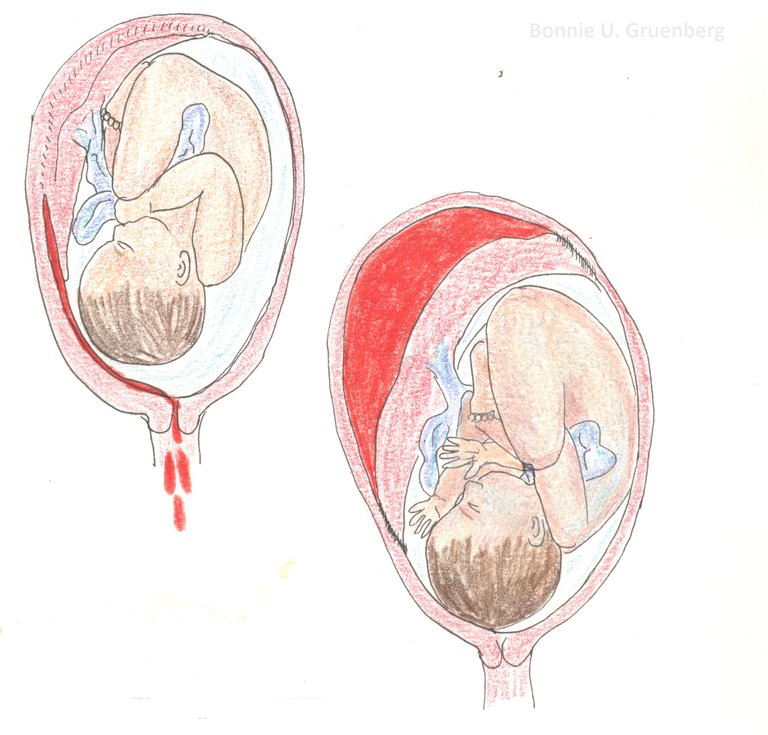
Before and after placenta abruption in the uterus with blood accumulated at the site
Least I forget, there is complete (placenta separates prematuredly completely) and incomplete abruption (in which part of it still remains embedded).
This condition is majorly caused by trauma to the the pregnant uterus during the period of pregnancy which could be through road traffic accidents, physical trauma directly or any other impact on the abdomen during the pregnancy period.
Some of the characteristic features that can be used in identifying this condition includes :
Pain which could be felt more at the lower back region, there could also be vaginal bleeding although not in all cases because in some situations the blood can collect within the uterus making it invisible to the eyes and this is what causes tenderness and tension which is also felt on assessment, the woman could become pale due to the severe blood loss, skin may be become cold and clammy.
If prompt attention is not given to the woman, which could be emergency Cesarean to save the life of the mother and baby especially if the pregnancy have gotten to term,
death of both the mother and baby can occur as a major complication, there will be shock which is due to the severe blood loss, other organs of the body may begin to shut down due to the severity of the blood loss which also helps in sustaining their functions.
I know someone may be wondering how this condition can be identified and attended to urgently, well ultrasound scan as well as blood test (to check if the fetal blood will be detected in the mother's blood) and urine tests can be used in addition to the characteristic features or symptoms mentioned above in confirming placenta abruption.
PLACENTA PREVIA
This also is a known complication or abnormality which is associated with the placenta, but instead of detaching like in the abruptio, its location changes in such a way that it completely or partially covers the cervix which is known as the neck of the womb and it's through it the baby as well as placenta is delivered.
So you can imagine what will happen when the only passage through which the baby and other products of conception can pass through is covered, this is why this condition is usually treated seriously to prevent further complications. Also vaginal delivery is also contraindicated in this condition, inorder not to worsen the situation.
Placenta previa is classified into four levels or types which are type 1 to type 4.
TYPE 1
Normally, the placenta is situated at the upper part of the uterus, but in this type of placenta previa, it's low lying which means it's embedded in the lower region of the uterus, towards the lateral aspect but not too close to the cervix which is why it's also referred to as low lying placenta. So this type of placenta previa is less threatening compared to the other types where the cervix is being covered.
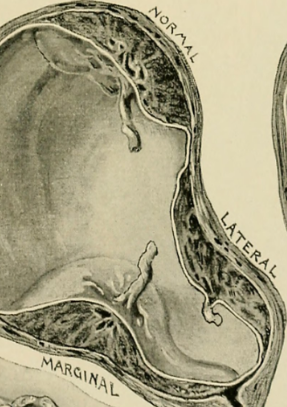
Low lying placenta on the lateral wall of the uterus
TYPE 2
This type is also known as marginal placenta and here, the placenta is embedded very close to the cervix with the edge pointing towards the cervix but not covering it yet, it's also known to have lesser complications compared to the other ones.
TYPE 3
This type of placenta previa is also called partial placenta previa and this is because just as the name goes it partially covers the cervical Os and by covering it, it closes the passage for the products of conception. This type of placenta previa has great complications as it's seen to be serious and with great complications if not well handled.
TYPE 4
The type 4 placenta previa is also known as the complete or central placenta previa and this is because this major organ totally covers the whole cervical Os centrally, leaving no opening at all. It is because of this, that ceaserean section is usually indicated or adviced inorder to save both mother baby from further complications which might occur during attempting spontaneous vaginal delivery.
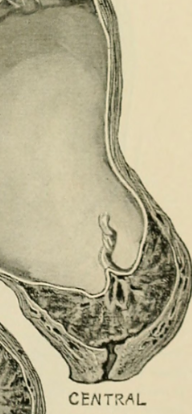
Type four central placenta previa
It's important to note that in this condition, the palpation of uterus or any activity on the abdomen that can trigger uterine contraction or irritation of the cervix is discouraged inorder not to trigger bleeding or any further complications. Also, vaginal examination which is routinely carried out during the monitoring of labour progress, is also discouraged to prevent aggravating the situation since it's ceaserean section that will be performed.
Having known what this condition is about as well as it's types, it will also be beneficial if we know the causes or risk factors of this complication and they include:
Previous history of placenta previa can be an indication of future ones, uterine fibroids could also affect the position for implantation resulting to this condition, implantation of the fertilized ovum at the lower part of the uterus instead of the upper part could also predispose to this condition etc
Some of the signs and symptoms that can help in identifying this condition are: bleeding from the vagina which is usually painless,and when this situation is not properly managed, severe bleeding which could result to shock may occur,the baby will be in distress because of its struggle in utero to get oxygen, if the bleeding becomes uncontrollable it may result to hysterectomy which is the removal of the uterus completely inorder to arrest the bleeding process and in situations which are out of control death could also occur which is why complications related to placenta is taken really seriously too during this period of pregnancy.
These situation can also be saved through Encouraging bed rest, avoiding anything that could irritate the uterus and cervix , commencing blood transfusion in cases of severe blood loss, conducting emergency ceaserean section to save both mother and baby.
PLACENTA ACCRETA
This is a condition in which the placenta is abnormally embedded deeper than normal in the uterine wall,making it difficult for separation during the third stage of labour which results to severe bleeding through the vagina after the process of delivery.
Usually, the placenta embeds in the endometrium which is the inner most part of the uterus (womb), but in this particular one it's seen to go deeper than usual but not up to the muscle layer of the uterus.
There's also placenta increta in which the placenta burrows into the muscle layer of the uterus which is called the myometrium making it a more severe form compared to the placenta accreta. Placenta perccreta is known to be the worst or most severe type in which the placenta embeds extremely deep crossing the muscle layers as well as the outer wall of the uterus affecting surrounding organs of the body which are situated close to it like the urinary bladder etc.
In this type, the bleeding is severe and hysterectomy which is the removal of the womb is usually the solution because of how deep the placenta embedded.
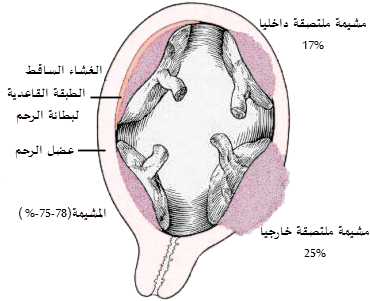
Normal embedding of placenta and the different Types of placenta accreta
The shocking aspect to this condition is that the location of the placenta could also be normal which is at the upper part and the pregnancy will also be normal except in some cases where slight bleeding could occur during the last 3months (trimester) of pregnancy, aside that diagnosing this condition is majorly through the help of ultrasound scan.
There are some factors that can predispose a woman to having placenta accreta and they are: record of previous history of placenta previa in the woman in any of her pregnancies, being pregnant at age greater than 30years, any surgery carried out on the uterus previously could also be a predisposing factor, aside the risk factors the major cause is not really well known.
RETAINED PLACENTA
Usually, the placenta is delivered during the third stage of labour within 30minutes after the baby is delivered, but in this condition, the placenta stays more than 30minutes which could be as a result of delay in the delivery and this delay during this 3rd stage of labour could be caused by either poor management of labour at this stage in which inadequate amount or none of oxytocin injection is administered to help the uterus contract there by releasing the placenta from the point of attachment.
This condition can also be caused by any of these above mentioned problems like the placenta accreta.
To prevent this or tackle this condition, prompt management of the third stage of labour is important in other to ensure adequate contraction of the uterus to release the placenta for delivery within 30minutes of the baby's delivery.
It is also worthy to note that some times some parts of the placenta like a lobe or part of the membrane could be traped inside even after delivery of the placenta and this is called partial retained placenta. This could cause serious infection with foul smelling odour in the woman, within the first few days or weeks after delivery (postpartum sepsis) and this in turn causes postpartum hemorrhage (bleeding).
Retained placenta can be caused by inability of the uterus to contract properly and this can be solved or prevented through administration of oxytocin, late pregnancy in women more than 35years of age is also a predisposing factor
Bleeding through the vagina during the third stage of labour after the baby is delivered could be a sign of retained placenta, poor uterine contraction, fever after some days, foul smelling odour with some tissue coming out of the vagina are also signs of retained placenta especially for partial retention.
I would like to also add as I summarize that in complete placenta retention,if after administration of the drugs the placenta doesn't come out, the removal will be done as a surgical procedure after delivery with the help of some instruments which will be used to separate it directly from the uterine wall under anasthesia. Close monitoring before and after the procedure is done.
I will stop at this point having explained some common abnormalities/ complications associated with placenta and I hope the article was simple enough to comprehend as well as beneficial too. I will gladly welcome your wonderful inputs, questions and ideas as regards this post. Thanks once again for your time and support.
REFERENCE
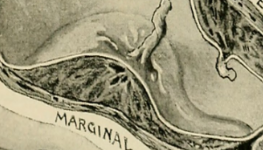
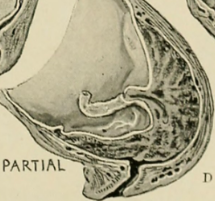
Very informative. Thank you for sharing.
!1UP
You have received a 1UP from @thecuriousfool!
@stem-curator, @vyb-curator, @pob-curator, @neoxag-curator, @pal-curatorAnd they will bring !PIZZA 🍕
Learn more about our delegation service to earn daily rewards. Join the family on Discord.
Thanks for this very complete and interesting post. I really enjoyed reading it. :)
I have one question concerning the usage of urine tests to detect signs of issues with placenta. What are we looking exactly into the urine? I assume this is not baby's blood, is it?
In addition, I also had the impression (from my simple experience) that issues with retained placenta were mostly easy to handle by doctors at the time of birth (at least in France). Can you confirm? Thanks in advance!
Cheers!
Thanks a lot @lemouth for always asking smart and interesting questions and also being supportive, am really happy you enjoyed the post.
The main reason for the urine test is just to help in ruling out the source of the bleeding, to know if it's from the urinary tract or system or from the reproductive system. Not basically that you will detect abruptio placenta in the urine. Secondly, the urine test is also done to know the state of the kidney if it's performing it's filtration function well,or if it's failing due to the volume of blood lost through bleeding and in that case albumin will be the major thing to be looking out for as its usually seen in urine when the kidney is bad.
To your second question, once such complicated situations arises, the removal of the placenta will be done by an obstetrician as a procedure most times in the theatre under anasthetic cover.
I hope I was able to answer your questions?
Thanks a lot for these clarifications.
Hence, if I got it correctly, the urine test is not useful alone, but must be considered together with other probes.
Yep this is how it happened the time I witnessed it. Immediately after delivery. It was done in 10-20 minutes.
Thanks a lot once again for answering my questions!
I'm glad my explanation went down well.
Congratulations @nazom! You have completed the following achievement on the Hive blockchain and have been rewarded with new badge(s):
Your next target is to reach 300 upvotes.
You can view your badges on your board and compare yourself to others in the Ranking
If you no longer want to receive notifications, reply to this comment with the word
STOPSupport the HiveBuzz project. Vote for our proposal!
Thanks for your contribution to the STEMsocial community. Feel free to join us on discord to get to know the rest of us!
Please consider delegating to the @stemsocial account (85% of the curation rewards are returned).
You may also include @stemsocial as a beneficiary of the rewards of this post to get a stronger support.
Sometimes I wonder how women managed to give birth in the wild, before medicine.
Hahahaha... Special breeds then with their peculiar patterns too.